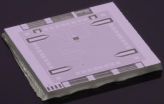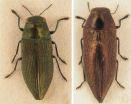(Press-News.org) Researchers at the National Institute of Standards and Technology (NIST) have created a tunable superconducting circuit on a chip that can place a single microwave photon (particle of light) in two frequencies, or colors, at the same time.
This curious "superposition," a hallmark of the quantum world, is a chip-scale, microwave version of a common optics experiment in which a device called a beam-splitter sends a photon into either of two possible paths across a table of lasers, lenses and mirrors. The new NIST circuit can be used to create and manipulate different quantum states, and is thus a prototype of the scientific community's long-sought "optics table on a chip."
Described in Nature Physics,* the NIST experiments also created the first microwave-based bit for linear optical quantum computing. This type of quantum computer is typically envisioned as storing information in either the path of a light beam or the polarization (orientation) of single photons. In contrast, a microwave version would store information in a photon's frequency. Quantum computers, if they can be built, could solve certain problems that are intractable today.
The new NIST circuit combines components used in superconducting quantum computing experiments—a single photon source, a cavity that naturally resonates or vibrates at particular frequencies, and a coupling device called a SQUID (superconducting quantum interference device). Scientists tuned the SQUID properties to couple together two resonant frequencies of the cavity and then manipulated a photon to make it oscillate between different superpositions of the two frequencies. For instance, the photon could switch back and forth from equal 50/50 proportions of both frequencies to an uneven 75/25 split. This experimental setup traps photons in a "box" (the cavity) instead of sending them flying across an optical table.
"This is a new way to manipulate microwave quantum states trapped in a box," says NIST physicist José Aumentado, a co-author of the new paper. "The reason this is exciting is it's already technically feasible to produce interesting quantum states in chip-scale devices such as superconducting resonators, and now we can manipulate these states just as in traditional optics setups."
NIST researchers can control how the new circuit couples different quantum states of the resonator over time. As a result, they can create sequences of interactions to make simple optical circuits and reproduce traditional optics experiments. For example, they can make a measurement tool called an interferometer based on the frequency/color of a single photon, or produce special quantum states of light such as "squeezed" light.
INFORMATION:
* E. Zakka-Bajjani, F. Nguyen, M. Lee, L.R. Vale, R.W. Simmonds and J. Aumentado. Quantum superposition of a single microwave photon in two different 'colour' states. Nature Physics. Posted online July 3, 2011.
NIST prototype 'optics table on a chip' places microwave photon in 2 colors at once
2011-07-08
ELSE PRESS RELEASES FROM THIS DATE:
California groundwater management trickles up from local sources
2011-07-08
In a typical year, California gets about 30 percent of its water from groundwater wells. Yet when it comes to managing this precious resource, the state of California relies on a mixed bag of more than 2,000 local water agencies with varying degrees of authority.
Critics say that this decentralized system leaves the state vulnerable to overdraft, which occurs when water is pumped out faster than replacement water is absorbed. But according to a new report published by Stanford University's Program on Water in the West, a surprising number of local water districts are ...
Graphene: What can go wrong? new studies point to wrinkles, process contaminants
2011-07-08
Using a combination of sophisticated computer modeling and advanced materials analysis techniques at synchrotron laboratories, a research team led by the University at Buffalo (UB) and including the National Institute of Standards and Technology (NIST), the Molecular Foundry at Lawrence Berkeley National Laboratory and SEMATECH* has demonstrated how some relatively simple processing flaws can seriously degrade the otherwise near-magical electronic properties of graphene.
Their new paper** demonstrates how both wrinkles in the graphene sheet and/or chance contaminants ...
Promising fire retardant results when clay nanofiller has space
2011-07-08
If materials scientists accompanied their research with theme songs, a team from the National Institute of Standards and Technology (NIST) and the University of Maryland (UMD) might be tempted to choose the garage punk song "Don't Crowd Me"* as the anthem for the promising, but still experimental nanocomposite fire retardants they are studying.
That's because the collaborators have demonstrated that the more widely and uniformly dispersed nanoscale plates of clay are in a polymer, the more fire protection the nanocomposite material provides.
Writing in the journal Polymer,** ...
Study suggests new strategy to prevent infertility, birth defects
2011-07-08
A strategy that has been shown to reduce age-related health problems in several animal studies may also combat a major cause of age-associated infertility and birth defects. Investigators from Massachusetts General Hospital (MGH) have shown that restricting the caloric intake of adult female mice prevents a spectrum of abnormalities, such as extra or missing copies of chromosomes, that arise more frequently in egg cells of aging female mammals. Their report appears in this week's online Early Edition of the Proceedings of the National Academy of Sciences USA.
"We found ...
The Brava System: How Does it Work?
2011-07-08
Brava breast enhancement is a clinically proven, nonsurgical method for enlarging your breasts. Brava utilizes tissue expansion, a method for enabling your body to grow extra skin tissue.
Brava consists of two domes with silicone gel rims that are worn over the breasts and held in place with a sports bra. A battery-powered microcomputer called a SmartBox creates and regulates a light vacuum within the domes.
This gentle tension within the domes stimulates tissue cells, causing them to multiply and generate new breast tissue. As new tissue develops, your breast size ...
Jewel beetles, obtained from local people, turn out to be 4 species unknown to science
2011-07-08
A team of researchers from the Czech University of Life Sciences discovered four new species of jewel beetles (Buprestidae) from South-eastern Asia. This family of beetles is named for their particularly beautiful body and fascinating, shiny colours.
"All new species belong to the genus Philanthaxia. Before the publication of this study, 61 species had been known from this genus. Currently, it comprises of 65 species, with a primarily Southeast-Asian distribution, except for two species extending to the Australasian region", said Oto Nakládal, a co-author of the study.
The ...
In a Car Wreck? Use the Ferrer Shane Accident Toolkit iPhone App
2011-07-08
In a world - a mobile world - where the words "cool" and "useful" are the primary ways to describe smartphone apps worth buying, apps provided by law firms have very seldom been described as cool or useful.
Will the Accident Toolkit, sponsored by the Miami personal injury lawyers of Ferrer Shane, be any different?
It actually might.
Many commentators have stated that lawyers' smartphone apps are just another marketing gimmick and will do very little to attract consumer interest, especially when it comes to those apps that are likely to be ...
Organizational climate drives commercialization of scientific and engineering discoveries
2011-07-08
WACO, Texas (July 7, 2011) – Research universities with an organizational climate that actively supports commercialization and encourages interdisciplinary collaboration among researchers are more likely to produce invention disclosures and patent applications, according to a Baylor University study.
Published online June 29 in the Journal of Research Policy, the study by Emily Hunter, Ph.D., assistant professor of management and entrepreneurship at Baylor University's Hankamer School of Business, showed that a favorable organizational climate had a sizeable and direct ...
Reducing the Stress of Co-Parenting After Divorce
2011-07-08
Children may face a difficult transition when newly divorced parents first start sharing their children's time with one another.Young children may have a difficult time understanding the new situation. However, by explaining as simply as possible the prospective changes in living arrangements -- before they occur -- and speaking to your child about how both parents will still love and care for him or her no matter what changes take place and no matter where everyone lives, the effect of a difficult transition can be minimized for the child, and undue worry and distress ...
Drug 'shield' helps target antibiotic resistant bacteria
2011-07-08
A new technique which targets antibiotic-resistant bacteria and shields patients from the toxic parts of an antibiotic drug has been developed by Cardiff University scientists.
Dr Elaine Ferguson from Cardiff University's School of Dentistry has utilised a new technique which attaches tiny nano-sized biodegradable polymers to the antibiotic drug - colistin.
Use of the drug colistin to fight infection has been limited as it is known to be toxic to the kidneys and nerves despite the fact that it has been found to be effective against new multi-drug resistant bacteria, ...


